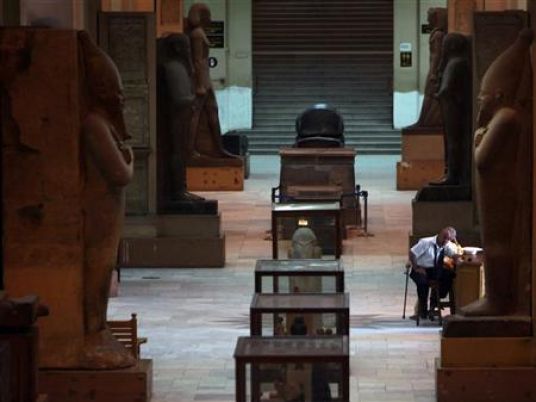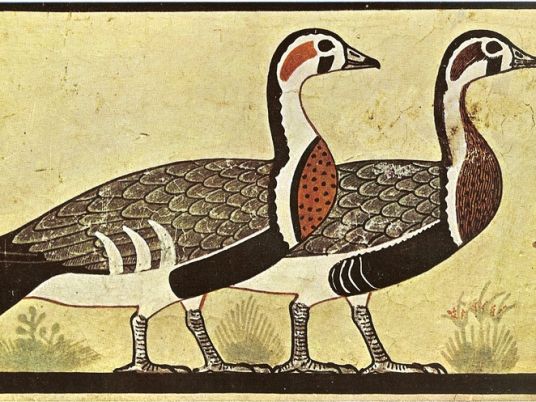
A controversy was raised when the head of the Italian archaeological mission in Egypt, Francesco Tiradritti, claimed the Meidum Geese painting, known as the Egyptian Mona Lisa, was fake.
Egyptian archaeologists, including former Antiquities Minister Zahi Hawass, called for the ministry to respond to the man’s allegations so as to protect the Egyptian heritage from skepticism campaigns.
The director of the Egyptian Museum told Al-Masry Al-Youm that Tiradritti evaluated the painting with his bare eye and did not publish his study in any scientific journal, adding that he will be refuted by documented scientific evidence.
But Tiradritti insisted that he based his claim on scientific evidence and careful research.
Egyptian Museum director rejects the claim:
Q: What is the story of that painting?
A: The archaeologist Mariette discovered this painting among many other pieces in an ancient tomb in 1871. The other pieces are exhibited in many museums around the world, including New York, Manchester and Copenhagen.
And when a renowned archaeologist like Mariette makes such a discovery, it is unbecoming to claim it is fake without scientific evidence. There are modern microscopes and cameras that can detect the smallest details, and there are devices that can determine the age of an artifact.
Q: What does Tiradritti base his claim on?
A: He says that type of geese did not exist at the time and did not appear in any cemetery discovered before. He also says it was painted with bright modern colors.
Q: Is that to true?
A: No, because the tomb of Nefermaat and his wife is distinctively decorated with bright colors all over.
Q: Did this type of geese not exist at the time?
A: All types of birds migrate from Europe to Egypt. Why should they not exist at the time?
Q: Did he use modern scientific techniques in examining the painting?
A: Of course not, he evaluated the painting with his bare eye and did not publish his study in any scientific journal. We will refute him with documented scientific evidence.
Q: How?
A: We have our modern devices that can examine the painting.
Q: Would this mean you are also doubting the originality of the painting?
A: No, it is only but a scientific method to respond to his claim.
Q: When will you do that?
A: Soon.
Tiradritti insists it is fake:
Q: How did all this start?
A: When I was organizing an exhibition about Egypt in Italy in 1998. An artist noticed that the size of the geese at the beginning and the end of the painting was identical, an artistic term called “Rhythmic Balance” unknown to ancient Egyptian art. This prompted me to examine the painting.
Q: What did you do exactly?
A: When my wife and I enlarged a photo of the painting, we found that the brush that was used was relatively modern and unknown to the ancient Egyptians.
Q: What other scientific evidence did you rely on?
A: Two types of the geese are known to live in Siberia and Finland, not in Egypt. These never appeared in other ancient Egyptian pieces of art. Also, the colors were not used before in the ancient Egyptian art, particularly the violet and the okra.
Q: Why do you think it was Luigi Vassalli who painted it?
A: Vassalli was a painter. He took this piece to display it in the Bulaq Museum in 1871. I studied all his papers and manuscripts. He wrote at length about his smallest discoveries, but there was no word about the painting, although it is a major discovery. Also, he displayed with the painting a piece with the initials “G” and “A” which are the first two letters of his wife’s name.
Q: Why did Mariette, who discovered the tomb, not doubt its originality?
A: Perhaps he did not realize the type of geese. Also, the painting was broken while moving it to the museum because it is made of fragile materials like clay and plaster, which makes me believe Vassalli repainted it in his own style. Maybe the original is beneath his painting.
Q: Were there other ancient Egyptian artifacts proven unoriginal?
A: Yes, museums all over the world are full of such examples, especially pieces that were bought from antique dealers who imitated originals. For example, the statue of Ahhotep, the mother of Ahmose who fought the Hyksos, was experimentally proven unoriginal. It is displayed at the British Museum, which has a hall specifically allocated for unoriginal pieces.
The Metropolitan Museum in New York has a piece picturing Queen Tiye in the form of a sphinx, and a statue of a Negro African of the 18th Dynasty. Both pieces are not originals.
Edited translation from Al-Masry Al-Youm

